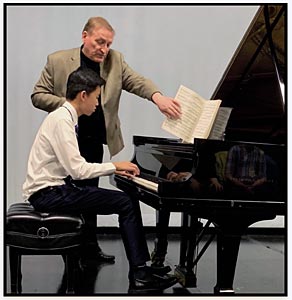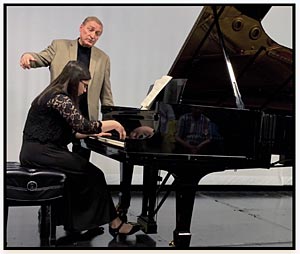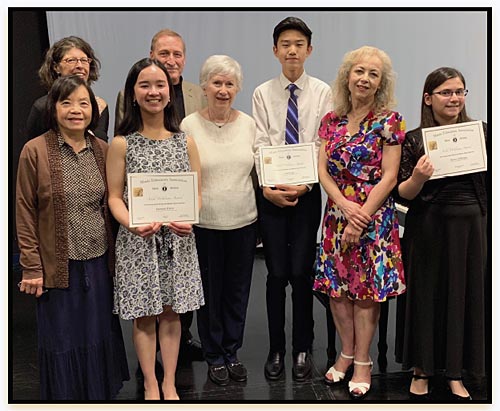Music Educators Association of New Jersey
Serving teachers and students since 1927




On a torrentially rainy Thursday morning, three Young Artists brought sunshine to the Wharton Institute where they played for Master Teacher Douglas Humpherys. Joan Bujacich, hostess, Annual Auditions chair and Master Class coordinator, welcomed the performers and Mr. Humpherys. He chairs the piano department at the Eastman School of Music and has performed internationally in concerts across four continents over the passed four decades, among other notable achievements.
The class began with Sunny Yu, student of Ana Berschadsky, playing the stirring first movement of Beethoven’s Sonata in D Minor, Opus 31, No. 2 (“The Tempest”). Many of Beethoven’s works have a symphonic quality, but this sonata is an exception. It is more operatic, filled with emotion, lots of voicing and unrealized expectations. There are five tempo markings in the first two lines. Wow! Beethoven never did that again. Traditionally, in an opera, a recitative would follow the opening Largo [first inversion dominant] chord, but it does not. Rather, we have an Allegro theme filled with 2-note slurs, which we tend to exaggerate. Don’t play them too bouncy; Mr. Humphreys emphasized it is more exciting to play the four descending 2-note slurs as one phrase in one motion. Play the Largo arpeggiated chord in the beginning as softly as you can and follow it with the three phrases containing the slurs, making each phrase louder than the next. The result is very dramatic and creates mystery. Look closely at the left hand that accompanies the slurs; there is actually more motion there.

Listen to the chord in measure 6 (Adagio) through to the last note, he urges; the ornament is meaningfully melodic, rather than decorative. Another pianissimo chord (m.7) takes us to the next Allegro theme (m. 9 - 13) where the left hand plays on the weak beats; this is so effective — as only Beethoven can do.
Moving on to the D minor section and the waves crashing in the ocean, the low left-hand notes set the tone. Young Artist Master Class June 13, 2019 Conducted by Douglas Humpherys Czerny described this as hearing muffled cries in the distance. Think of playing in 2, not in 4. Bring out the low notes for full dramatic effect.
After several other false chordal starts throughout, we arrive at m. 148, when we finally hear the soprano recitative that moves us forward to the end. This piece is filled with revelation and innovation. Mr. Humpherys encourages the performer to “direct the orchestra, be in charge of the dynamics!”

Alyssa Zylberger, student of Sophia Agranovich, artistically performed Liszt’s Un Sospiro, the calming Concert Etude No. 3. This was a deeply felt piece, which Alyssa obviously connected to emotionally and exhibited great sensitivity. Mr. Humpherys affirms that the melody line is difficult to make work, because the very structure of it is separated by the left hand turning over the right. He encourages that before you begin to play, imagine the first D flat — listen to it and think about it. Then play gently and evenly, curving your fingers a bit so you can achieve a more fluid, warmer tone. Don’t stretch your fingers trying to reach all the keys; it can produce a flat sound. Practice slowly at first, with the pedal depressed; you’ll be able to hear every note this way. You want to produce a whole motion with each arpeggio.
In terms of dynamics, you want to crescendo within every four arpeggios (two measures), rather than within each arpeggio. Count across two bars. The same applies when you encounter the variations with octaves; play through the whole phrase of two measures. Lift the melody out of the piano.
This is essentially a theme and variations and each variation has something the composer wants you to discover and communicate. Phrasing is the key to making every variation unique and building toward a dramatic finish.
The third performance was by Jasmine Meyer, student of Julia Lam. The Nocturne (Opus 38, No. 4) by Lowell Liebermann was refreshingly contemporary — discordant yet truly beautiful and sensitively played. This was another theme and variations in form that, while melancholy in flavor, packed its own dramatic punch. Three musical elements create character here: 1) The intervals that begin the theme are 2nds, 3rds, 4ths — close together — then suddenly a 9th creates a leap and drama. Experience the leap, Mr. Humphreys says, like a dancer floating. 2) Look for pattern changes in the left hand — with new harmony. 3) The opening phrase is all about the downbeats; the upbeats change the character and make you listen.

The dynamic range in this is truly dramatic in that the music goes from ppp to ffff and back again. The theme starts out fairly simply and grows in complexity while the dynamics expand with it. Each variation of eight measures has its own character. In the opening theme, both hands play in the treble, creating a “spacey” feeling. Then the left hand changes direction, moving to a very low bass, very quiet. In the pianissimo section Mr. Humpherys instructs to make it “spider-webby” — very legato with almost no pulse. Then switch again to a syncopated variation with the right hand following the left; the pedal creates a foundation here and shades of color fall within it. In the variation with the 16ths, there is more motion — twinkling stars and counterpoint. Try to shape the righthand melody even though you have chords; keep the melody line more horizontal than vertical.
All three selections heard today, although different and by different composers, have certain commonalities — basically theme and variations that create great drama. As a pianist, how do you find your own voice that is distinctive without sounding eccentric? Reach into the score and find something new. Clues come from the composer. Discover the details, the fine points and give the piece character.
Congratulations, Young Artists!

(l. to r. front) Julia Lam with Jasmine, Ana Berschadsky with Sunny and Sophia Agranovich with Alyssa; (back) Joan Bujacich and Doug Humpherys. Joan presented each student with the Adell Williams Award for Young Artist achievement.
MEA graciously thanks County College of Morris for the Master Class audition space and for use of the beautiful Steinway B piano. Thank you to Alan Wasserman and Bertha Mandel who judged that Saturday in June. And thank you to the Wharton Institute, who allowed us to use their space for the Master Class when our regular venue was not available. Kudos also to Cherwyn Ambuter for providing refreshments while we socialized after the event.
Charlene Step, Writer & Layout Designer
Lisa Gonzalez, Photography